Creating a System of IOE-PDPTA to Bridge Tourists and Poster Designers: An Application of IOE in Personalized Poster Design
Abstract
:1. Introduction
2. Literature Review
2.1. Data Analysis for Personalized Trip Recommendations
2.2. Influence of Keywords on Visual Designers of Travel Advertisements
3. IOE-Based Design System
3.1. IOE Framework for Design Industry
3.2. IOE-PDPTA
3.3. Data Collection in IOE-PDPTA
3.4. Converting Original to Textual Data
3.5. Cleaning Textual Data
3.6. Determining Candidate Topics and Keywords
3.7. Verifying Keywords with Spatial Rationality
4. Simulations
4.1. Experiment Environment
4.2. Data Collection
4.3. First LDA Grouping
4.4. Second Round of LDA Grouping
4.5. Spatial Rationality of Tourism Topics and Keywords
4.6. Performance Comparisons between Proposed Method and the Most Common Previous Method
5. Conclusions
Author Contributions
Funding
Institutional Review Board Statement
Informed Consent Statement
Data Availability Statement
Acknowledgments
Conflicts of Interest
Appendix A
| Group | Keywords |
|---|---|
| 1 | “address”, “photo”, “place”, “art”, “tourism”, “consort”, “like”, “introduction”, “characteristic”, “history”, “feeling”, “style”, “location”, “attract”, “see”, “appreciation”, “style”, “map”, “feel”, “free”, “full”, “beautiful”, “provide”, “appropriate”, “museum”, “operate”, “lovely”, “tourist”, “recommend”, “park”, “enter”, “next”, “subject”, “step in”, “fans group”, “white”, “second stage”, “present”, “friend”, “installation”, “keep”, “current”, “share”, “combine”, “pretty”, “interesting”, “life”, “scene”, “atmosphere”, “travel”, “welcome”, “join”, “walk”, “photo”, “romantic”, “Japanese-style”, “paint”, “house”, “using”, “angle retro”, “first floor”, “display”, “collocation”, “internal”, “inspection”, “a period of”, “walk”, “holiday”, “build” |
| 2 | “accommodation”, “home stay”, “travel”, “recommend”, “snack”, “extension”, “hotel”, “Shen Nong”, “Anping”, “garden”, “museum”, “night market”, “beef soup”, “Chiayi”, “concatenation”, “message”, “Chimei”, “not bad”, “salt pan”, “page”, “Discount”, “tunnel”, “church”, “market”, “Nantou”, “Parent-child”, “changhua”, “immigration”, “Slip slides”, “world”, “share”, “anticipate”, “breakfast”, “Chigu”, “Salt Mountain”, “set”, “pregnant”, “welcome”, “Europe”, “Okinawa” Yunlin”, “Netherlands”, “characteristic”, “experience”, “join”, “missed”, “farm”, “trace”, “cell phone”, “honeymoon” Sugar factory”, “miss”, “place”, “lunch”, “Hong Kong”, “Kerry”, “grow”, “green”, “grocery store”, “white” optimization”, “cabin”, “parenting”, “coffee”, “freedom”, “modify”, “Sicao”, “ lottery”, “at home and abroad”, “Taitung” |
| 3 | “park”, “tourist”, “park”, “ecology”, “green”, “beauty”, “experience”, “travel”, “neighborhood”, “tunnel”, “tourism”, “world”, “suggestion”, “traffic”, “Beautiful”, ““recommend”, “free”, “landscape”, “proceed”, “interchange”, “address”, “route”, “scenery”, “parking”, “leisure”, ““road”, “take”, “Socially verified icons”, “admire”, “Taijiang”, “drive”, “Qigu”, “public”, “guide tour”, “facility”, “scenery”, “Sicao”, “accommodation”, “direction”, “arrival”, “parent-child”, “dock”, “sunset”, “farm”, “Beimen”, “abundant”, “offer”, “forest”, “urban”, “use”, “fast”, “holiday”, “fare”, “regular ticket”, “Salt Mountain”, “choose”, “travel”, “enter”, “spectacular”, “reference”, “sky”, “private”, “platform”, “hot spring”, “map”, “Xinying”, “mode”, “place”, “nature”, “convenient” |
| 4 | “see”, “a bit”, “know”, “feeling”, “compare”, “not bad”, “place”, “stuff”, “look”, “photo”, “side”, “like”, “picture”, “friend”, “pity”, “leave”, “prepare”, “cute”, “happy”, “remember”, “night”, “heard”, “nearby”, “continue”, “return”, “opportunity”, “well”, “delicious”, “going back home”, “find”, “immediate”, “walk”, “before”, “break”, “decide”, “end”, “back”, “small”, “proceed”, “sightseeing” encounter”, “think”, “line up”, “kind of”, “share”, “pretty”, “introduction”, “want”, “door”, “interest”, “consort”, “think”, “recently”, “air-condition”, “morning”, “famous”, “comfortable”, “down”, “a little”, “back”, “suggestion”, “method”, “need”, “children”, “departure”, “thanks”, “hope”, “camera”, “cheap”, “inside |
| 5 | “delicious”, “flavor”, “address”, “operation”, “flavor”, “store”, “recommend”, “fresh”, “good” compare”, “signboard”, “snack”, “like”, “boss”, “choose”, “dining”, “menu”, “beverage”, “breakfast”, “price”, “collocation”, “fruit”, “nearby”, “delicious”, “black tea”, “full”, “feeling”, “business”, “simple”, “beef”, “Guohua”, “old shop”, “soybean pudding”, “see”, “market”, “queue”, “ice cream”, “shrimp”, “pudding”, “seat”, “handmade”, “opposite”, “guest”, “second stage”, “refreshing”, “famous”, “takeaway”, “soup”, “milk”, “cheap”, “rich”, “crispy”, “day of closed”, “a period of”, “rich”, “introduction”, “beef soup”, “food record”, “lunch”, “meet”, “sausage”, “snack”, “red bean”, “night market”, “cake”, “direct”, “next door”, “a second”, “map” |
| 6 | “game”, “children”, “link”, “cute”, “painted”, “happiness”, “work”, “complete”, “extension”, “question”, “punch”, “marriage”, “ North gate”, “challenge”, “perfect”, “animals”, “need”, “love”, “world”, “church”, “process”, “good”, “couple”, “crystal”, “wants”, “factory”, “open”, “white”, “teacher”, “scene”, “free”, “read”, “intimate”, “stories”, “way”, “physical”, “Films”, “art”, “wedding dress”, “processing”, “carry on”, “Changhua”, “welcome”, “caused”, “hope”, “seen”, “Chiayi”, “effect”, “professional”, “increase”, “favorite”, “view”, “Yunlin”, “idol Drama”, “becomes”, “participation”, “get”, “stereoscopic”, “cartoon”, “color”, “body”, “book”, “park”, “select”, “participate”, “shoot”, “ photo”, “learn”, “company”, “knowledge” |
| 7 | “antiquities”, “Anping”, “history”, “castle”, “Tree House”, “North Gate”, “Foreign firm”, “tour”, “castle town”, “tourists”, “out”, “memorial”, “museum”, “Confucius Temple”, “Old Street”, “park”, “former residences”, “Eternal Golden Fort”, “birthday”, “park”, “ancient”, “Chikan Tower”, “milkfish”, “crystal”, “department”, “Koxinga”, “factory”, “Chi Mei”, “Cultural Relic”, “free”, “ Banyan Tree”, “extension”, “traditional”, “church”, “reading”, “Japanese occupation”, “memorial”, “association”, “art”, “present”, “Qigu”, “Yongkang”, “garden”, “western”, “salt pan”, “China”, “Shanhua”, “ice cream”, “temple”, “renovation”, “important”, “themes”, “only exist”, “square”, “painted”, “official residence”, “New Taipei city”, “national”, “exhibit”, “Hai-Shan”, “coffee”, “wedding dress”, “Japanese-style”, “full”, “Diva”, “Tait & Co.”, “early”, “regular ticket”, “Qing Dynasty”, “Tianfu” |
| Group | Keywords |
|---|---|
| 1 | “selling”, “civilization”, “cafe”, “base”, “sun”, “exquisite”, “cottage”, “modern”, “smart”, “luxury”, “sandal”, “artwork”, “blue print”, “graffiti”, “ancient house”, “rainbow”, “style”, “lifelike”, “delicate”, “playful”, “rural”, “cloister”, “simple”, “master”, “eave”, “craft”, “teleplay”, “lively”, “hidden”, “Nikkei”, “aftertaste”, “blue sky”, “white cloud”, “former residence”, “inherit”, “make a wish”, “blistering summer day”, “corridor”, “clever hand”, “blessedness”, “vintage”, “quiet”, “slow”, “shiny green”, “rain”, “color painting”, “foreign”, “wooden house”, “leisure”, “tait”, “hall”, “low key”, “handrail”, “architect”, “coffee”, “tea house”, “maintain”, “repair”, “early”, “sakura”, “cabinet”, “warm”, “lamplight”, “snake”, “big tree”, “monument”, “exploration”, “ceremony”, “nostalgic”, “pool”, “garden” |
| 2 | “scallion cake”, “bean thread”, “Amin”, “hulled rice”, “Red brick wall”, “curry”, “teh tarik”, “retrospective exhibition”, “Si-tsho office”, “wooden”, “flavor”, “Chou’s”, “appetizer”, “bench”, “Nagio”, “Mini version”, “indian”, “lyrics”, “Home-made”, “seafood”, “aerial root”, “kimchi”, “Glacial table”, “ancient house”, “fresh”, “spicy”, “chat”, “pattern”, “eat and drink”, “Lily”, “flavors”, “entertain”, “traditional market”, “river water”, “fresh and tender”, “academy”, “corner”, “canvas”, “pepper”, “counter”, “sweetness level”, “floating”, “kitchen”, “digestion”, “taste good”, “fragrant”, “soybean milk”, “American”, “plump”, “seat”, “Red Bean Soup”, “seawater”, “butter”, “Amazon River”, “Maisonette”, “dishes”, “duck blood”, “sesame oil”, “Dongxing”, “intellectual”, “canteen”, “owner”, “rich”, “black tea”, “drink”, “gold”, “pleasant aftertaste”, “Ba wan”, “Hot pot shop”, “Japanese army”, “clear”, “chicken wing”, “fairyland”, “former residence”, “soy sauce braised foods”, “soy sauce”, “exodermises”, “squid” |
| 3 | “creamy”, “refreshing”, “fatty meat”, “glass noodles”, “Amin”, “curry”, “Call number”, “delicious”, “close up”, “late night supper”, “wash”, “Vanilla”, “Chou’s”, “appetizer”, “Nagio”, “Shoulder pole”, “deep blue”, “Tasting”, “tour”, “kimchi”, “seafood”, “order”, “home-made”, “greedy”, “Rice flour”, “brother”, “juice”, “hot and sour”, “Ton-gji”, “signboard”, “Kangxi”, “Lily”, “platter”, “entertain”, “dig in”, “hot meal”, “green beans”, “delicious”, “grandma”, “pepper”, “mayor”, “pig’s head”, “sweetness level”, “rice cake”, “kitchen”, “moon Shadow”, “baking”, “taste good”, “pork”, “pork”, “kind”, “sweet”, “dessert”, “Osmanthus”, “tofu”, “Guohua”, “Tiangong”, “flat food”, “chicken rise”, “dishes”, “swordfish”, “hard bean curd”, “sesame oil”, “stinky tofu”, “Dongxing”, “fish soup”, “owner”, “fish maw”, “lemon juice”, “black tea” |
| 4 | “creamy”, “refreshing”, “mellow”, “fatty meat”, “glass noodles”, “Amin”, “curry”, “delicious”, “ late night supper”, “vanilla”, “early adopters”, “flavor”, “Zhou’s”, “appetizer”, “originate”, “section third”, “Sauerkraut”, “fragrant”, “peanut butter”, “side dish”, “order dishes”, “Achuan”, “honey”, “Kimchi”, “seafood”, “order”, “Rice flour”, “fishbone”, “ham”, “juice”, “granule”, “slice”, “ask a price”, “spices”, “platter”, “meticulous”, “both full”, “vegetables”, “full”, “market”, “Bar”, “fresh and tender”, “crispy”, “green bean”, “pepper”, “Grandma”, “fish thick soup”, “micro”, “sweetness level”, “rice cake”, “floating”, “sold out”, “digestion”, “braised egg”, “pork”, “salinity”, “fragrant”, “seductive”, “sweet”, “closed”, “Coffin bread”, “radish”, “butter”, “dish”, “gravy”, “sesame oil”, “steamed”, “stinky tofu”, “fish soup”, “canteen” fish maw”, “fairy grass”, “lemon juice”, “Shi Jing”, “fat”, “tabasco”, “materials”, “peanuts”, “pork liver”, “meat ball” |
| 5 | “pigeon”, “youngster”, “fluorescent”, “arcade”, “closed”, “wedding photo”, “Dachan”, “heartwarming”, “chase”, “creatures Gongyuan Rd.”, “North gate”, “abundant”, “artwork”, “vast”, “sperm “whale”, “brick building”, “recreation”, “collection of books”, “lecture hall”, “graffiti”, “beer”, “avenue”, “hinterland”, “blanket”, “hide”, “taxi”, “natural history”, “countryside”, “Japanese”, “citizen”, “cloister”, “public”, “dessert”, “quiet”, “riverside”, “specimen”, “elementary school”, “squirrel”, “Mediterranean”, “farmhouse”, “Showa”, “outdoor”, “Zhongzheng”, “youngster”, “exhibition”, “inherited”, “wish”, “dressing”, “almond tea”, “museum”, “retro”, “quiet”, “countryside”, “painted”, “boutique”, “light”, “metamorphosis”, “skewers”, “Japanese occupation”, “vintage”, “coastal”, “Confucius”, “Lioujia”, “drink tea”, “Governor”, “Koxinga”, “official residence”, “vehicle”, “early” |
| 6 | “witness”, “chessboard”, “condescending”, “nature”, “three-section compound”, “campus”, “forest”, “lingering charm”, “visit”, “temple”, “sperm whale”, “blissful”, “Guantian”, “farmland”, “amusement park”, “heron”, “cabbage”, “recreation”, “salt manufacturing”, “bosky”, “volcano”, “avenue”, “sunshade”, “dense”, “sunset”, “lights”, “plank road”, “alley”, “saltwork”, “Wusantou”, “joss”, “saltwater”, “serenity”, “Japanese”, “pray”, “singer”, “solemn”, “rustic”, “earth”, “crystallization”, “sea water”, “Christmas”, “solar salt”, “reflection”, “Guiren”, “Showa”, “Zuozhen”, “japanese occupation”, “washing”, “sugar manufacturing”, “Japanese army”, “original”, “snacks”, “sakae”, “dowry”, “scenic area”, “abandoned”, “coastal”, “childhood”, “roof tile”, “Taiwanese Hokkien”, “reservoir”, “tile”, “Alishan”, “evening”, “talismanic”, “playground”, “Liujia”, “watchtower”, “salt industry” |
| 7 | “old temple”, “officer”, “Liuhe”, “fundraising”, “high-ranking officers”, “three-section compound”, “magazine”, “Dacheng”, “Yanagiya”, “relief”, “campus”, “demolition”, “moat”, “originate”, “Qianlong in Qing dynasty”, “deposit”, “brick-making”, “palatial”, “Guandi temple”, “Yongli”, “board”, “navy”, “royal”, “worship”, “Kangxi”, “manner”, “tablet”, “city gate tower”, “magistrate”, “guard”, “guardian”, “seat of honour”, “ancient city”, “stone lion”, “academy”, “landing”, “stone turtle”, “joss”, “emperor”, “defense”, “spring and autumn”, “ambulatory”, “porch”, “event”, “spread”, “culture and education”, “solemn”, “pilgrim”, “ancestor”, “rebar”, “craft”, “history”, “Showa”, “official”, “Xiaodongmen”, “Japanese occupation”, “historic”, “quaint”, “dome”, “trace”, “Japanese army”, “Lin Shuangwen”, “original”, “old temple”, “gateway”, “vicissitudes”, “Buddhist monastery”, “gods”, “Qing Dynasty”, “mansion” |
| Designer | Topics | Keywords |
|---|---|---|
| Student Designer | Old streets and alleys | “civilization”, “blue print”, “master”, “craft”, “light hand”, “low profile”, “adventure” |
| Anping food | “scallion pie”, “seafood”, ““eat and drink”, “serving”, “fragrant”, “fertile”, “landlady” | |
| Guohua Street food | “mung bean noodles”, “appetizer”, “Tong-Ji”, “hot food”, “delicious”, “Guohua”, “stinky tofu” | |
| Old City Food | “fatty meat”, “smell”, “seafood”, “plate”, “grandma”, “fragrant”, “dishes” | |
| Village and museum | “chase”, “recreation”, “avenues”, “squirrel”, “farmer”, “ light and shadow”, “Confucius” | |
| Coastal and rural | “forest”, “heron”, “sunset”, “serenity”, “silhouette”, “coastal”, “salt industry” | |
| Historic landmark | “magazine”, “moat”, “Kangxi”, “stone lion”, “events”, “ Japanese occupation”, “Japanese army” | |
| Population poster | “modern”, “red brick”, “young”, “fatty meat”, “nature”, “visit”, “old temple” | |
| Online Designer (Practical) | Old streets and alleys | “sell”, “ancient house”, “craft”, “cloud”, “quiet”, “teahouse”, “nostomania” |
| Anping food | “A Ming”, “Zhou’s”, “Yueying”, “Lily”, “floating”, “sesame oil”, “meatball” | |
| Guohua street food | “delicious”, “squid”, “juice”, “delicious”, “rice cake”, “turkey rice”, “stinky tofu” | |
| Old City food | “vanilla”, “peanut butter”, “seafood”, “vegetables”, “mung bean”, “pork”, “deep-fried sandwich” | |
| Village and museum | “wedding photo”, “artwork”, “taxi”, “citizen”, “farmer”, “museum”, “vintage” | |
| Coastal and rural | “temple”, “heron”, “saltwork”, “rustic”, “sugar manufacturing”, “coast”, “salt industry” | |
| Historic landmark | “old temple”, “brick-making”, “worship”, “stone lion”, “pilgrim”, “craft”, “gods” | |
| Population poster | “coffee shop”, “retrospective exhibition”, “close-up”, “pigeon”, “forest”, “Liuhe” | |
| Online Designer (Artistic) | Old streets and alleys | “cabin”, “blue print”, “ancient house”, “ Japanese occupation”, “blue sky and white cloud”, “wooden house”, “railing” |
| Anping food | “scallion pie”, “appetizer”, “spicy”, “flavor”, “sugariness”, “duck blood”, “aftertaste” | |
| Guohua street food | “fatty meat”, “rice noodles”, “signboard”, “rice cake”, “Guohua”, “swordfish”, “lemon juice” | |
| Old City food | “side dishes”, “order dishes”, “seafood”, “fishbone”, “braised egg”, “deep-fried sandwich”, “canteen” | |
| Village and museum | “pigeon”, “artwork”, “brick-making”, “museum”, “natural history”, “squirrel”, “outdoor” | |
| Coastal and rural | “temple”, “farmland”, “heron”, “sunset”, “saltwork”, “seawater”, “watchtower” | |
| Historic landmark | “moat”, “brick-making”, “city gate tower”, “stone lion”, “academy”, “stone turtle”, “pilgrim” | |
| Population poster | “coffee shop”, “scallion pie”, “delicious”, “young”, “tasty”, “checkerboard”, “temple” |
References
- Gupta, N.; Khosravy, M.; Patel, N.; Dey, N.; Gupta, S.; Darbari, H.; Crespo, R.G. Economic data analytic AI technique on IoT edge devices for health monitoring of agriculture machines. Appl. Intell. 2020, 50, 3990–4016. [Google Scholar] [CrossRef]
- Wu, J.M.T.; Li, Z.; Srivastava, G.; Yun, U.; Lin, J.C.W. Analytics of high average-utility patterns in the industrial internet of things. Appl. Intell. 2021, 52, 6450–6463. [Google Scholar] [CrossRef]
- Kamilaris, A.; Ostermann, F.O. Geospatial analysis and the internet of things. ISPRS Int. J. Geo-Inf. 2018, 7, 269. [Google Scholar] [CrossRef]
- Dhiman, G.; Nagar, A.K.; Vimal, S.; Rho, S. Guest Editorial: Cybertwin-Driven 6G for Internet of Everything: Architectures, Challenges, and Industrial Applications. IEEE Trans. Ind. Inform. 2022, 18, 4846–4849. [Google Scholar] [CrossRef]
- Mohanty, S.P.; Yanambaka, V.P.; Kougianos, E.; Puthal, D. PUFchain: A Hardware-Assisted Blockchain for Sustainable Simultaneous Device and Data Security in the Internet of Everything (IoE). IEEE Consum. Electron. Mag. 2020, 9, 8–16. [Google Scholar] [CrossRef]
- Nozari, H.; Szmelter-Jarosz, A.; Ghahremani-Nahr, J. The Ideas of Sustainable and Green Marketing Based on the Internet of Everything—The Case of the Dairy Industry. Futur. Internet 2021, 13, 266. [Google Scholar] [CrossRef]
- Mohapatra, H.; Rath, A.K. IoE based framework for smart agriculture. J. Ambient. Intell. Humaniz. Comput. 2022, 13, 407–424. [Google Scholar] [CrossRef]
- Miraz, M.H.; Ali, M.; Excell, P.S.; Picking, R. A Review on Internet of Things (IoT), Internet of Everything (IoE) and Internet of Nano Things (IoNT). In Proceedings of the 2015 Internet Technologies and Applications (ITA), Wrexham, UK, 8–11 September 2015; pp. 219–224. [Google Scholar]
- Thakur, N.; Han, C.Y. A study of fall detection in assisted living: Identifying and improving the optimal machine learning method. J. Sens. Actuator Netw. 2021, 10, 39. [Google Scholar] [CrossRef]
- Matijevich, E.S.; Volgyesi, P.; Zelik, K.E. A promising wearable solution for the practical and accurate monitoring of low back loading in manual material handling. Sensors 2021, 21, 340. [Google Scholar] [CrossRef]
- Sharma, N.; Chakraborty, A.K. Implementation of dynamic controls for grid-tied-inverters through next-generation smart meters and its application in modernized grid. Energies 2022, 15, 988. [Google Scholar] [CrossRef]
- Abbasi, A.; Sarker, S.; Chiang, R.H.L. Big Data Research in Information Systems: Toward an Inclusive Research Agenda. J. Assoc. Inf. Syst. 2016, 17, 2. [Google Scholar] [CrossRef]
- Shih, Y.C.; Chi, C.F.; Lin, R.F.; Lin, R.T. Past highlights and future of human factors and design thinking in Taiwan. J. Manag. Syst. 2018, 25, 321–365. [Google Scholar]
- Joyce, A. Inclusive design. Nielsen Norman Group. Available online: https://www.nngroup.com/articles/inclusive-design/ (accessed on 30 January 2022).
- Horozov, T.; Narasimhan, N.; Vasudevan, V. Using Location for Personalized POI Recommendations in Mobile Environments. In Proceedings of the International Symposium on Applications on Internet, Phoenix, AZ, USA, 23–27 January 2006; pp. 124–129. [Google Scholar]
- Chiang, H.-S.; Huang, T.-C. User-adapted travel planning system for personalized schedule recommendation. Inf. Fusion 2015, 21, 3–17. [Google Scholar] [CrossRef]
- Lu, E.H.-C.; Chen, C.-Y.; Tseng, V.S. Personalized Trip Recommendation with Multiple Constraints by Mining User Check-in Behaviors. In Proceedings of the 20th ACM SIGSPATIAL International Conference on Advances in Geographic Information Systems, Redondo Beach, CA, USA, 6–9 November 2012; pp. 209–218. [Google Scholar]
- Ye, M.; Yin, P.; Lee, W.-C. Location Recommendation for Location-Based Social Networks. In Proceedings of the Advances in Geographic Information Systems, San Jose, CA, USA, 2–5 November 2010; pp. 458–461. [Google Scholar]
- Ying, J.J.C.; Lu, E.H.C.; Kuo, W.N.; Tseng, V.S. Urban Point-of-Interset Recommendation by Mining User Check-in Behaviors. In Proceedings of the UrbComp ’12: The ACM SIGKDD International Workshop on Urban Computing, Beijing, China, 12 August 2012; pp. 55–62. [Google Scholar]
- Kim, J.; Kim, H.; Ryu, J.-h. Trip Tip: A Trip Planning Service with Tag-Based Recommendation. In Proceedings of the Conference on Human Factors in Computing Systems, Boston, MA, USA, 4–9 April 2009; pp. 3467–3472. [Google Scholar]
- Zhang, Z.; Morimoto, Y. Collaborative Hotel Recommendation Based on Topic and Sentiment of Review Comments. In Proceedings of the Forum for Information and Engineering, Gifu, Japan, 6–8 March 2017. [Google Scholar]
- Zheng, V.W.; Zheng, Y.; Xie, X.; Yang, Q. Collaborative Location and Activity Recommendations with GPS History Data. In Proceedings of the Internet Conference on World Wide Web, Raleigh, NC, USA, 26–30 April 2010; pp. 1029–1038. [Google Scholar]
- Huang, C.; Wang, Q.; Yang, D.; Xu, F. Topic Mining of Tourist Attractions Based on a Seasonal Context Aware LDA Model. Intell. Data Anal. 2018, 22, 383–405. [Google Scholar] [CrossRef]
- Liu, Y.; Ester, M.; Hu, B.; Cheung, D.W. Spatio-Temporal Topic Models for Check-in Data. In Proceedings of the IEEE International Conference on Data Mining, Atlantic City, NJ, USA, 14–17 November 2015; pp. 889–894. [Google Scholar]
- Park, S.-T.; Liu, C. A study on topic models using LDA and Word2Vec in travel route recommendation: Focus on convergence travel and tours reviews. Pers. Ubiquitous Comput. 2020, 26, 429–445. [Google Scholar] [CrossRef]
- Shafqat, W.; Byun, Y.C. A Recommendation Mechanism for Under-Emphasized Tourist Spots Using Topic Modeling and Sentiment Analysis. Sustainability 2020, 12, 320. [Google Scholar] [CrossRef]
- Amatriain, X.; Lathia, N.; Pujol, J.M.; Kwak, H.; Oliver, N. The Wisdom of the Few A Collaborative Filtering Approach Based on Expert Opinions from the Web. In Proceedings of the SIGSIR, Boston, MA, USA, 19–23 July 2009. [Google Scholar]
- Lee, C.-S.; Chang, Y.-C.; Wang, M.-H. Ontological recommendation multi-agent for Tainan City travel. Expert Syst. Appl. 2009, 36, 6704–6753. [Google Scholar] [CrossRef]
- Zheng, Y.; Xie, X. Learning travel recommendations from user-generated GPS traces. ACM Trans. Intell. Syst. Technol. 2011, 2, 1–29. [Google Scholar] [CrossRef]
- Yoon, H.; Zheng, Y.; Xie, X.; Woo, W. Smart Itinerary Recommendation Based on User-Generated GPS Trajectories. In Proceedings of the University of Illinois at Chicago, Xi’an, China, 26–29 October 2010; pp. 19–34. [Google Scholar]
- Dang, S.; Golden, A.G.; Cheung, H.S.; Roos, B.A. Telemedicine Applications in Geriatrics. In Brocklehurst’s Textbook of Geriatric Medicine and Gerontology; Elsevier: Amsterdam, The Netherlands, 2010. [Google Scholar]
- Nitschke, M.; Krackowizer, A.; Hansen, A.L.; Bi, P.; Tucker, G.R. Heat health messages: A randomized controlled trial of a preventative messages tool in the older population of South Australia. Int. J. Environ. Res. Public Health 2017, 14, 992. [Google Scholar] [CrossRef]
- Holloway, J.C. Marketing for Tourism; Pearson Education Ltd.: Harlow, UK, 2004. [Google Scholar]
- Magyar, C.E. The Discourse of Tourism and National Heritage: A Constrastive Study from a Cultural Perspective. Ph.D. Thesis, Autonomous University of Madrid, Madrid, Spain, 2014. [Google Scholar]
- Morgan, N.; Pritchard, A. Advertising in Tourism and Leisure; Butterworth-Heinemann: Oxford, UK, 2000. [Google Scholar]
- White, K.S. Effective Poster Design. In Undergraduate Honors Capstone Projects; Utah State University: Logan, UT, USA, 2012; Volume 116. [Google Scholar]
- Kalyani, V.L.; Sharma, D. IoT: Machine to machine (M2M), device to device (D2D) internet of everything (IoE) and human to human (H2H): Future of communication. J. Manag. Eng. Inf. Technol 2015, 2, 17–23. [Google Scholar]
- Shilpa, A.; Muneeswaran, V.; Rathinam, D.D.K.; Santhiya, G.A.; Sherin, J. Exploring the Benefits of Sensors in Internet of Everything (IoE). In Proceedings of the 2019 5th International Conference on Advanced Computing & Communication Systems (ICACCS), Coimbatore, India, 15–16 March 2019; pp. 510–514. [Google Scholar]
- Srinivasan, C.; Rajesh, B.; Saikalyan, P.; Premsagar, K.; Yadav, E.S. A review on the different types of Internet of Things (IoT). J. Adv. Res. Dyn. Control Syst. 2019, 11, 154–158. [Google Scholar]
- Ma, W.-Y.; Chen, K.-J. Introduction to CKIP Chinese Word Segmentation System for the First International Chinese Word Segmentation Bakeoff. In Proceedings of the SIGHAN Workshop on Chinese Language Processing, Sapporo, Japan, 11–12 July 2003; pp. 168–171. [Google Scholar]
- Lu, R.-S.; Tsao, H.-Y.; Lin, H.-C.K.; Ma, Y.-C.; Chuang, C.-T. Sentiment analysis of brand personality positioning through text mining. J. Inf. Technol. Res. 2019, 12, 93–103. [Google Scholar] [CrossRef]
- Wu, T.-T.; Wu, Y.-T. Applying project-based learning and SCAMPER teaching strategies in engineering education to explore the influence of creativity on cognition, personal motivation, and personality traits. Think. Ski. Creat. 2020, 35, 100631. [Google Scholar] [CrossRef]
- Lye, A.; Cicirello, A.; Patelli, E. An efficient and robust sampler for Bayesian inference: Transitional Ensemble Markov Chain Monte Carlo. Mech. Syst. Signal Process. 2022, 167, 108471. [Google Scholar] [CrossRef]
- Ma, D.; Gao, J.; Zhang, Z.; Zhao, H. Identifying atmospheric pollutant sources using a machine learning dispersion model and Markov chain Monte Carlo methods. Stoch. Environ. Res. Risk Assess. 2021, 35, 271–286. [Google Scholar] [CrossRef]
- Mongwe, W.T.; Mbuvha, R.; Marwala, T. Locally Scaled and Stochastic Volatility Metropolis–Hastings Algorithms. Algorithms 2021, 14, 351. [Google Scholar] [CrossRef]
- Miao, N.; Zhou, H.; Mou, L.; Yan, R.; Li, L. Cgmh: Constrained Sentence Generation by Metropolis-Hastings Sampling. In Proceedings of the AAAI Conference on Artificial Intelligence, Honolulu, HI, USA, 29–31 January 2019; pp. 6834–6842. [Google Scholar]
- Griffiths, T.L.; Steyvers, M. Finding Scientific Topics. Proc. Natl. Acad. Sci. USA 2004, 101, 5228–5235. [Google Scholar] [CrossRef]
- Godin, F.; Slavkovikj, V.; De Neve, W.; Schrauwen, B.; Van de Walle, R. Using Topic Models for Twitter Hashtag Recommendation. In Proceedings of the Interner Conference World Wide Web, Rio de Janeiro, Brazil, 13–17 May 2013; pp. 593–896. [Google Scholar]
- Porteous, I.; Newman, D.; Ihler, A.; Asuncion, A.; Smyth, P.; Welling, M. Fast Collapsed Gibbs Sampling for Latent Dirichlet Allocation. In Proceedings of the ACM Internet Conference Knowledge Discovery and Data Mining, Las Vegas, NV, USA, 24-27 August 2008; pp. 569–577. [Google Scholar]
- Vosecky, J.; Jiang, D.; Leung, K.W.-T.; Ng, W. Dynamic Multi-Faceted Topic Discovery in Twitter. In Proceedings of the ACM Internet Conference on Information & Knowledge Management, San Francisco, CA, USA, 27 October–1 November 2013; pp. 879–884. [Google Scholar]
- Ester, M.; Kriegel, H.-P.; Sander, J.; Xu, X. A Density-Based Algorithm for Discovering Clusters in Large Spatial Databases with Noise. In Proceedings of the Internet Conference on Knowledge Discovery and Data Mining, Portland, OR, USA, 2–4 August 1996; pp. 226–231. [Google Scholar]
- PIXNET. Available online: https://www.pixnet.net/ (accessed on 9 June 2021).
- The Numbers of Tourists Visiting Each Attraction in Tainan City. Available online: https://admin.twtainan.net/zh-tw/touriststatistics?category=%E9%81%8A%E5%AE%A2%E7%B5%B1%E8%A8%88 (accessed on 9 February 2022). (In Chinese).
- CKIP CoreNLP Toolkits. Available online: https://github.com/ckiplab/ckipnlp (accessed on 9 June 2021).
- Topic Modeling with Latent Dirichlet Allocation. Available online: https://pypi.org/project/lda/#history (accessed on 9 June 2021).
- Github: Scikit-Learn-Contrib/Hdbscan. Available online: https://github.com/scikit-learn-contrib/hdbscan (accessed on 9 June 2021).
- CHIMEI MUSEUM. Available online: https://www.chimeimuseum.org/ml/English/3 (accessed on 9 June 2021).
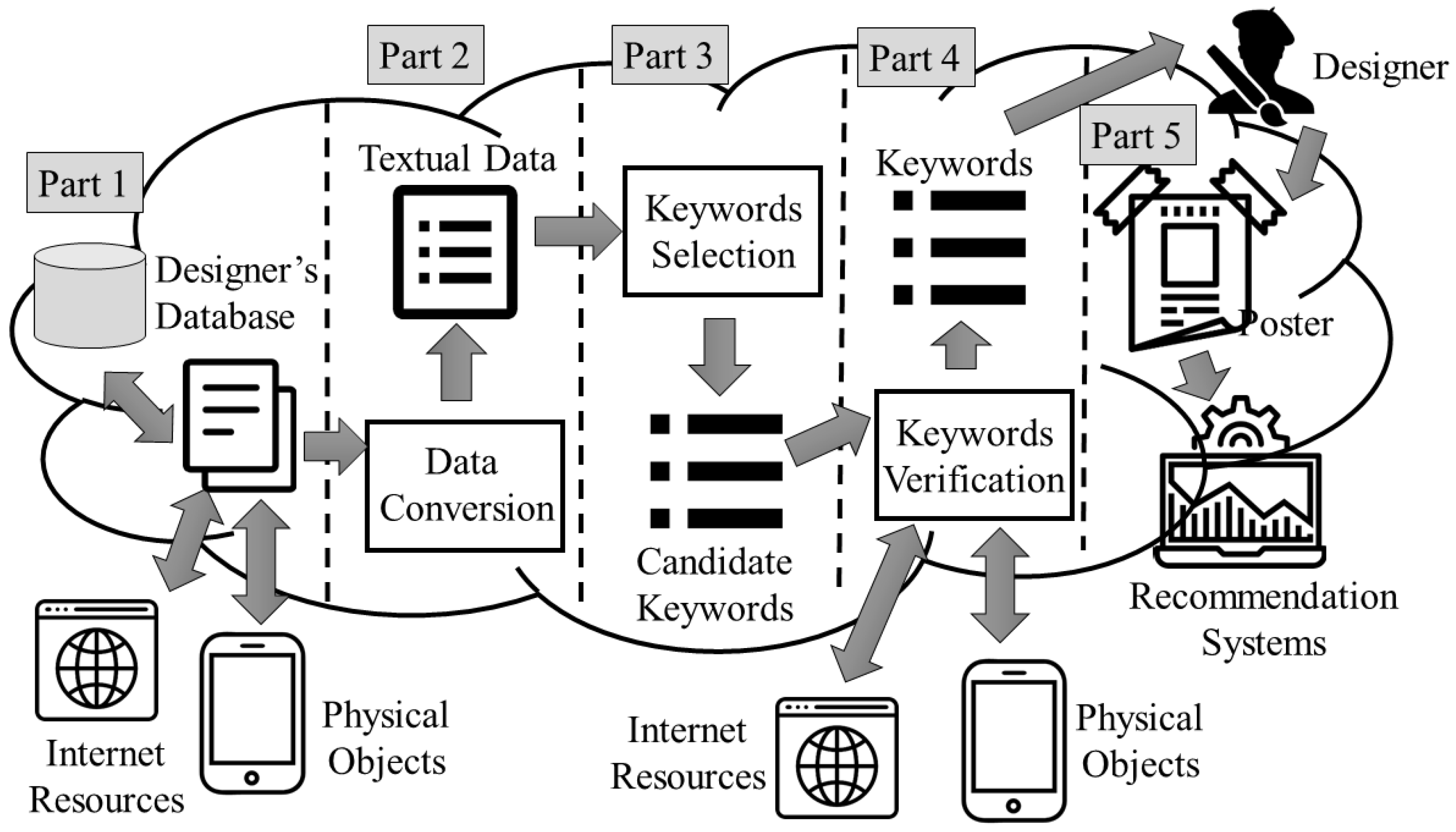

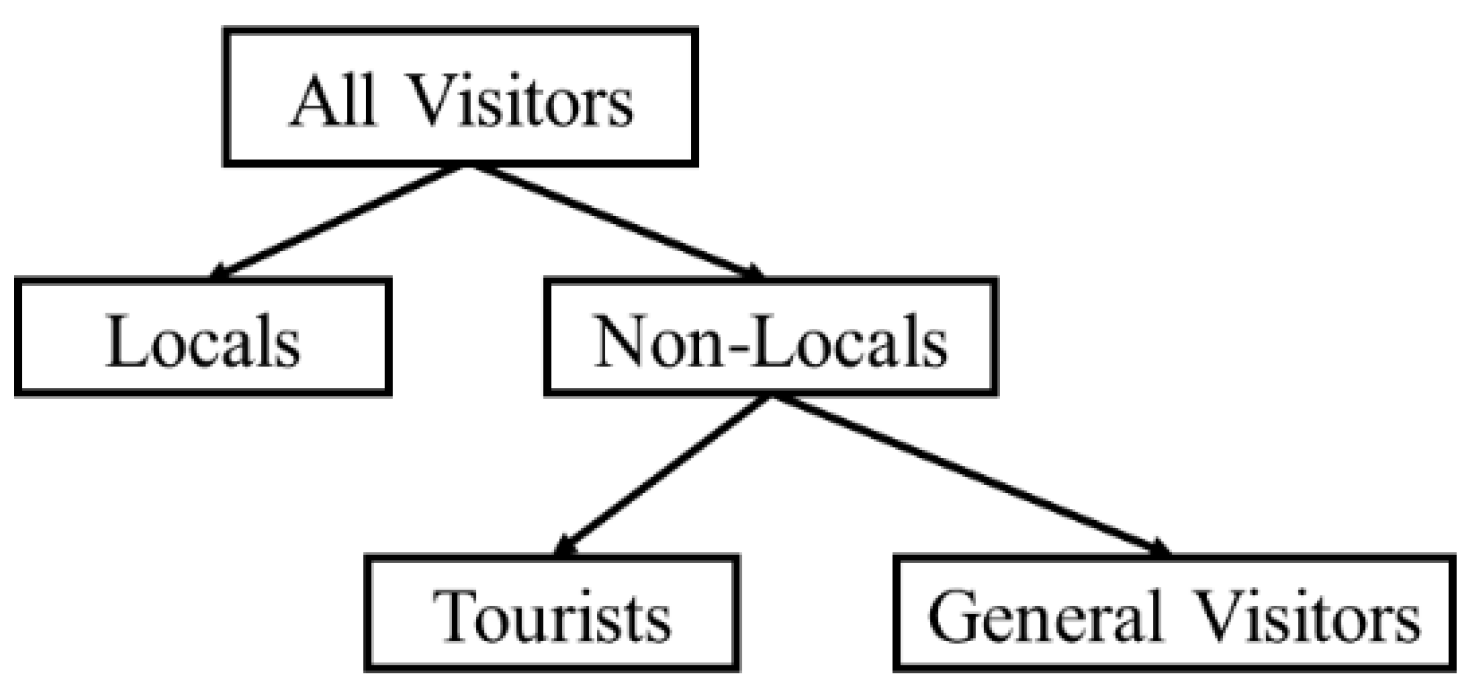
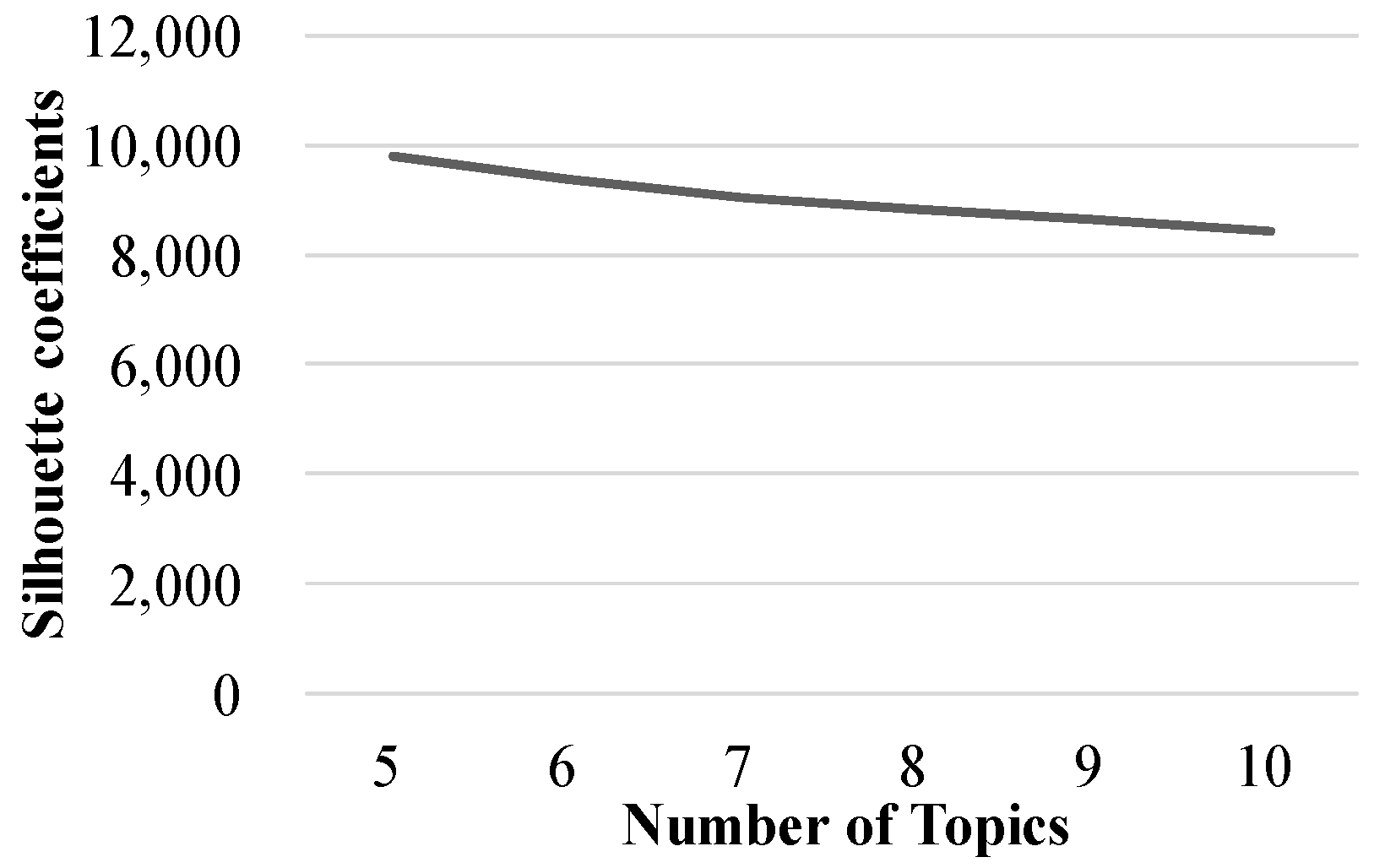
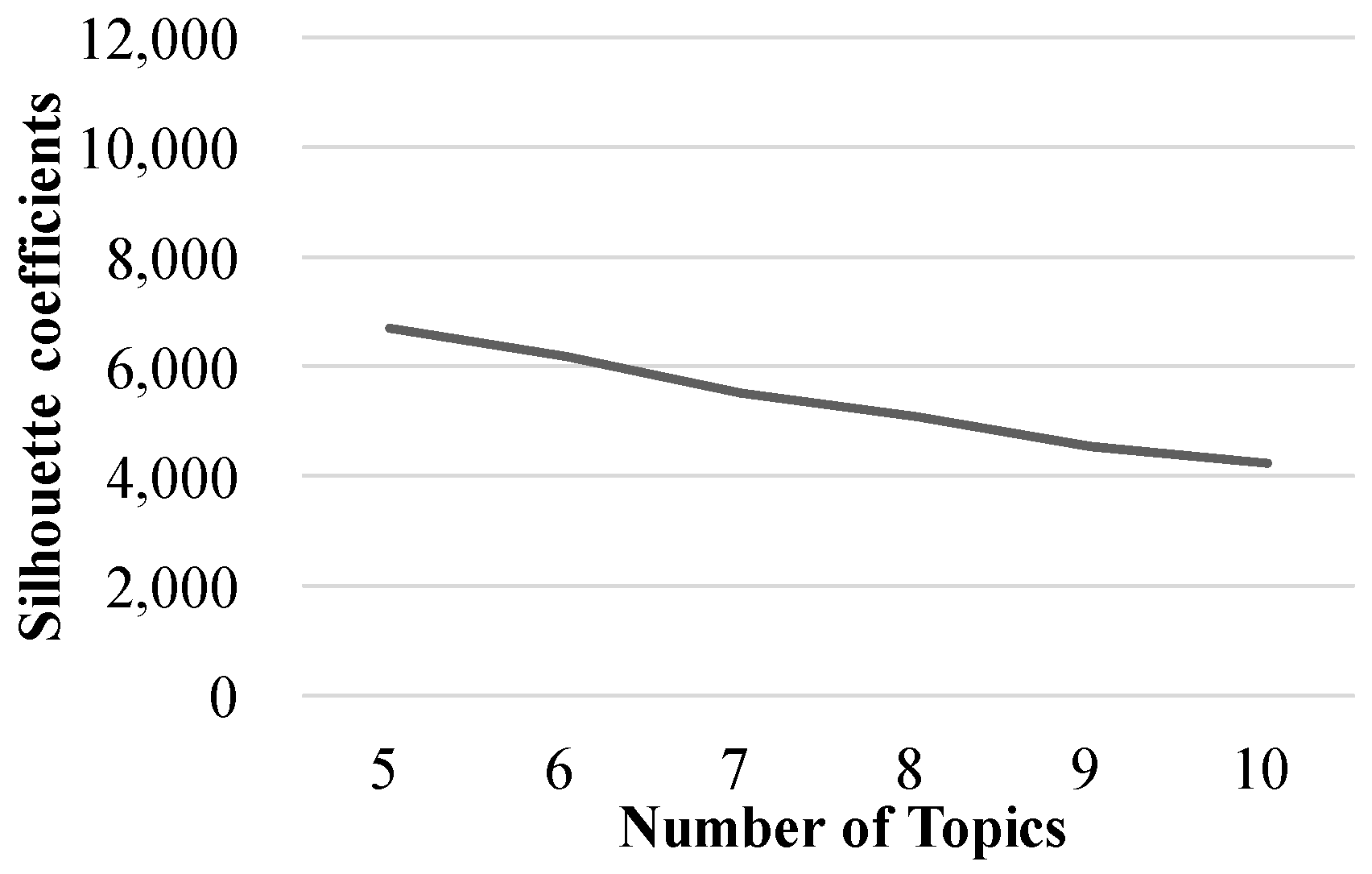
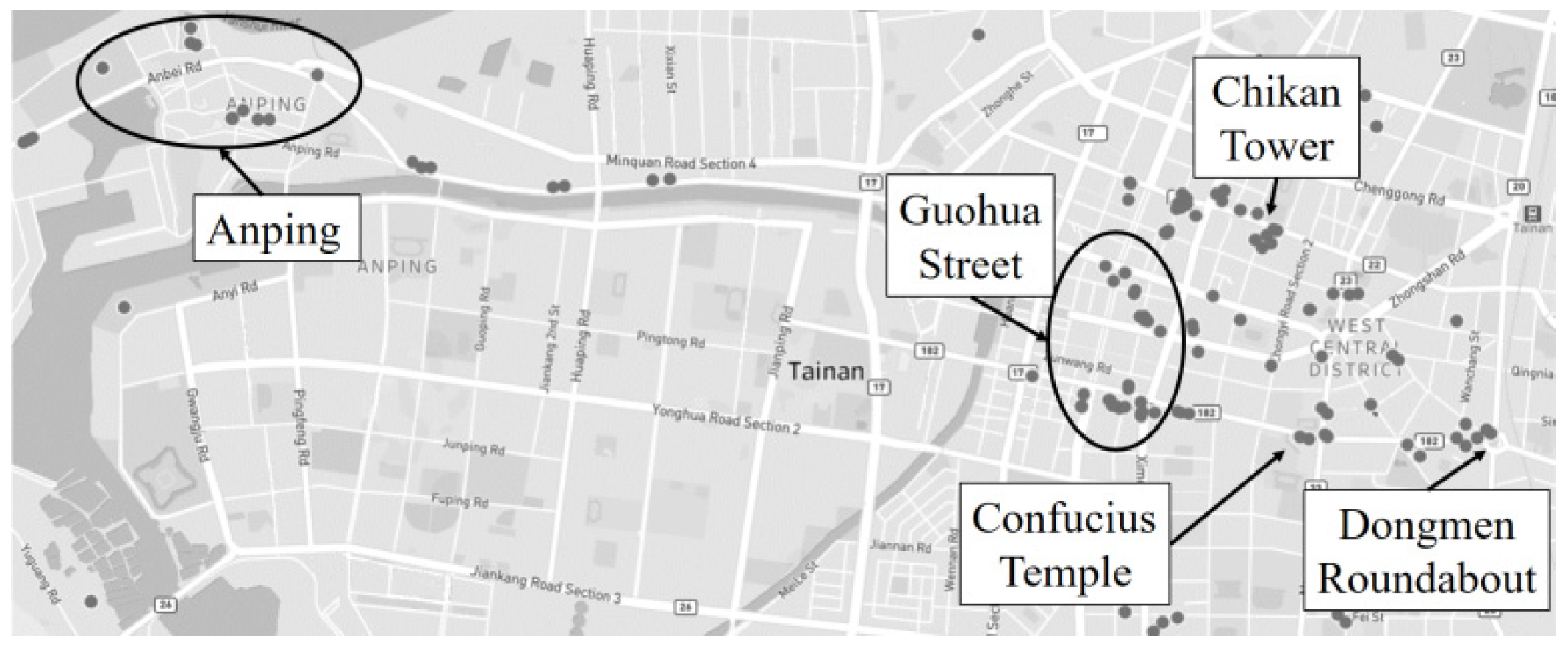

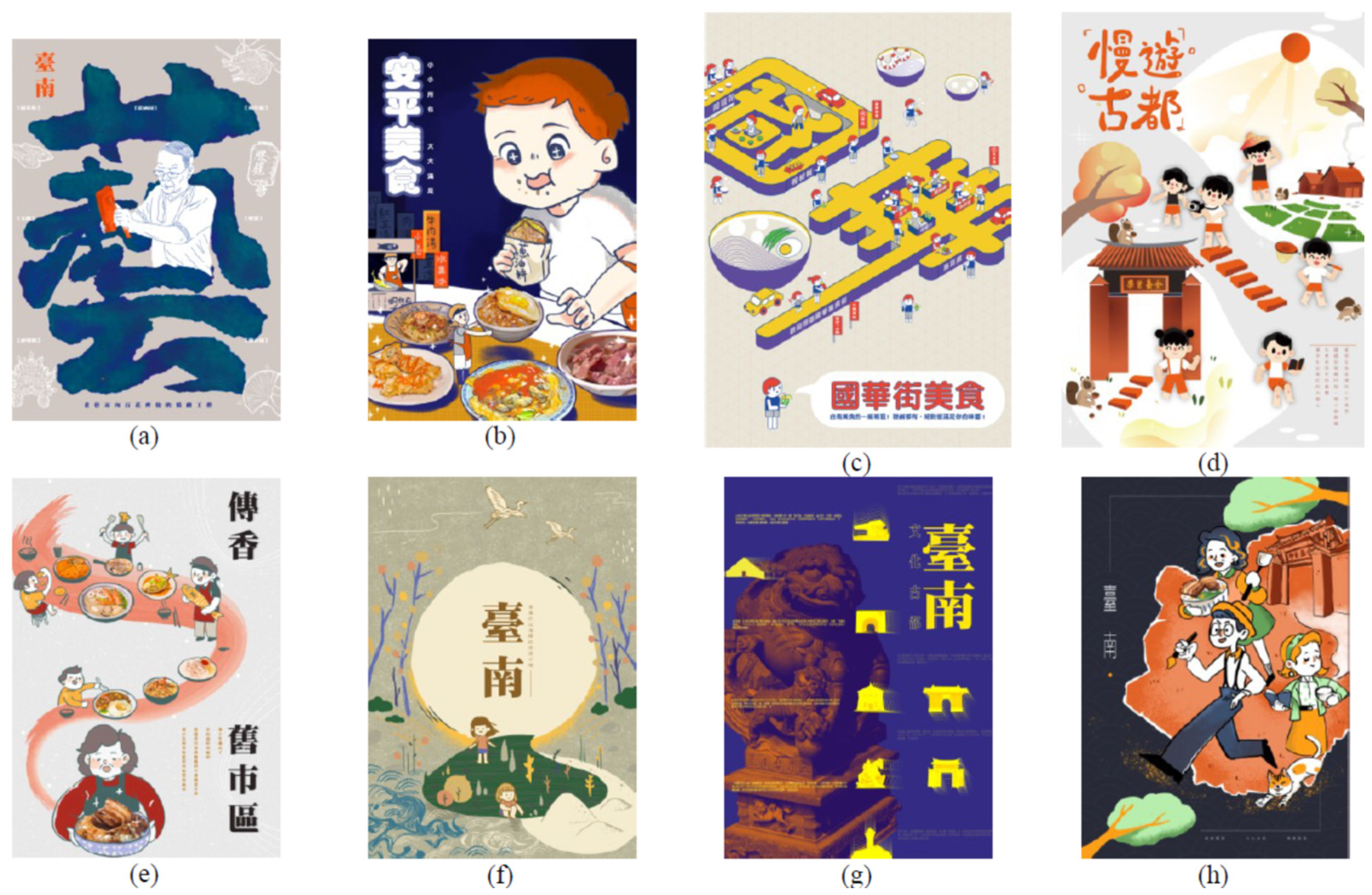
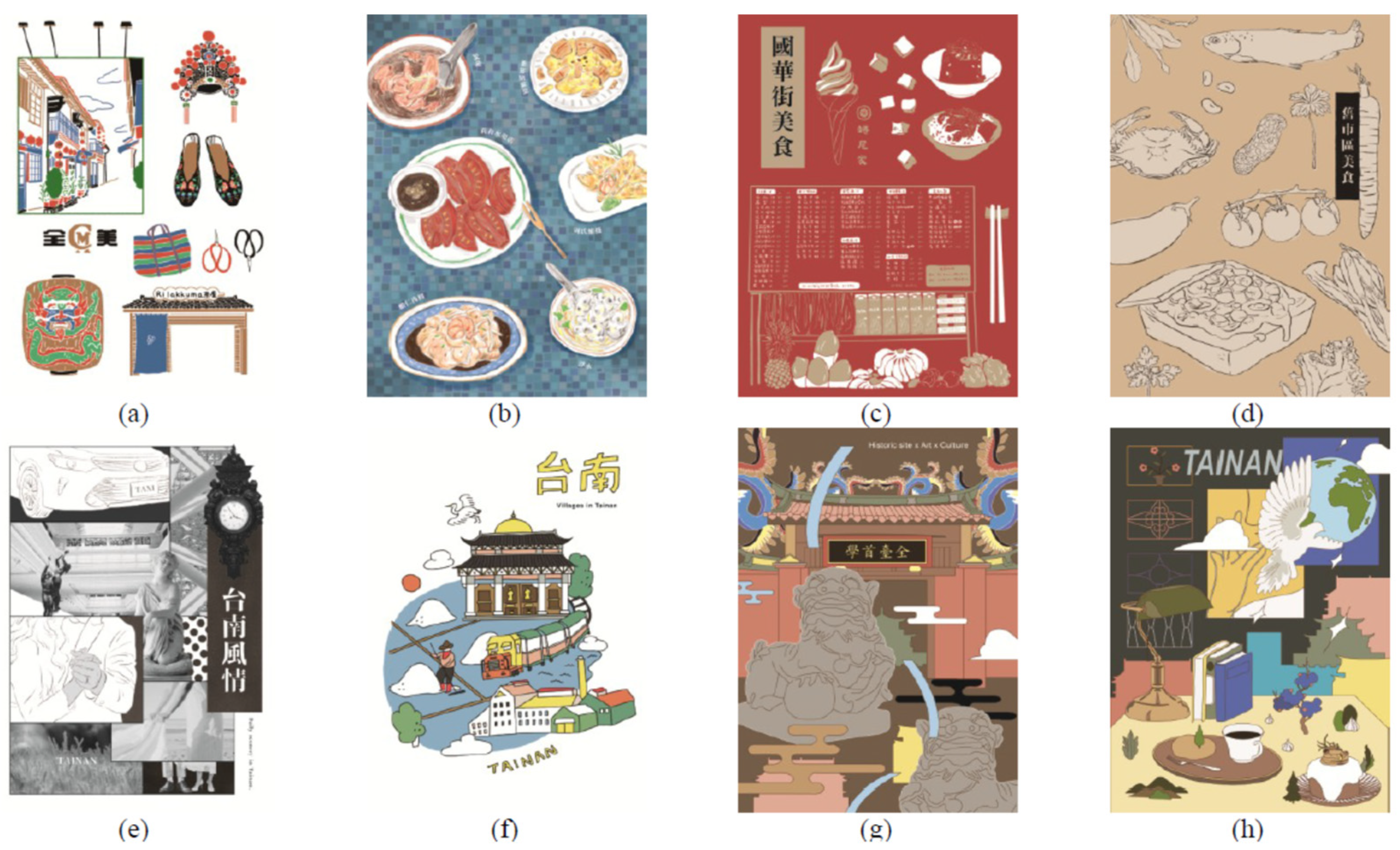

| Text\Group | 1 | 2 | 3 | 4 | 5 |
|---|---|---|---|---|---|
| 1 | 0.09 | 0.11 | 0.27 | 0.15 | 0.33 |
| 2 | 0.09 | 0.27 | 0.38 | 0.11 | 0.14 |
| 3 | 0.33 | 0.09 | 0.87 | 0.78 | 0.61 |
| Group\Objective | 1 | 2 | 3 | 4 | 5 | 6 | 7 |
|---|---|---|---|---|---|---|---|
| 1 | 0.01 | 0.03 | 0.02 | 0.04 | 0.06 | 0.05 | 0.74 |
| 2 | 0.02 | 0.84 | 0.10 | 0.06 | 0.07 | 0.01 | 0.02 |
| 3 | 0.05 | 0.05 | 0.88 | 0.05 | 0.06 | 0.04 | 0.07 |
| 4 | 0.45 | 0.03 | 0.02 | 0.43 | 0.43 | 0.01 | 0.12 |
| 5 | 0.07 | 0.05 | 0.04 | 0.06 | 0.08 | 0.94 | 0.05 |
| Personalized Advertisements Displayed\Designer | Student Designer | Online Designer (Practical) | Online Designer (Artistic) |
|---|---|---|---|
| Favorite topic (1) | 65.32% | 58.06% | 49.19% |
| Second-favorite topic (2) | 62.10% | 50.81% | 40.32% |
| Third-favorite topic (3) | 55.65% | 49.19% | 36.29% |
| (1) and (2) | 81.45% | 67.74% | 70.16% |
| (1) abd (3) | 76.61% | 70.16% | 63.71% |
| (2) and (3) | 76.61% | 66.13% | 58.06% |
| Top 3 favorites (i.e., (1), (2), and (3)) | 85.48% | 73.39% | 78.23% |
| Personalized Advertisements Displayed\Designer | Student Designer | Online Designer (Practical) | Online Designer (Artistic) |
|---|---|---|---|
| Favorite topic (1) | 72.58% | 64.52% | 43.55% |
| Second-favorite topic (2) | 68.55% | 64.52% | 46.77% |
| Third-favorite topic (3) | 66.13% | 55.65% | 50.00% |
| (1) and (2) | 87.90% | 77.42% | 60.48% |
| (1) and (3) | 85.48% | 73.39% | 63.71% |
| (2) and (3) | 76.61% | 72.58% | 66.94% |
| Top 3 favorites (i.e., (1), (2), and (3)) | 88.71% | 79.84% | 73.39% |
Publisher’s Note: MDPI stays neutral with regard to jurisdictional claims in published maps and institutional affiliations. |
© 2022 by the authors. Licensee MDPI, Basel, Switzerland. This article is an open access article distributed under the terms and conditions of the Creative Commons Attribution (CC BY) license (https://creativecommons.org/licenses/by/4.0/).
Share and Cite
Chang, T.-Y.; Chen, Y.-C. Creating a System of IOE-PDPTA to Bridge Tourists and Poster Designers: An Application of IOE in Personalized Poster Design. Systems 2022, 10, 125. https://doi.org/10.3390/systems10040125
Chang T-Y, Chen Y-C. Creating a System of IOE-PDPTA to Bridge Tourists and Poster Designers: An Application of IOE in Personalized Poster Design. Systems. 2022; 10(4):125. https://doi.org/10.3390/systems10040125
Chicago/Turabian StyleChang, Tsen-Yao, and Yi-Chung Chen. 2022. "Creating a System of IOE-PDPTA to Bridge Tourists and Poster Designers: An Application of IOE in Personalized Poster Design" Systems 10, no. 4: 125. https://doi.org/10.3390/systems10040125







